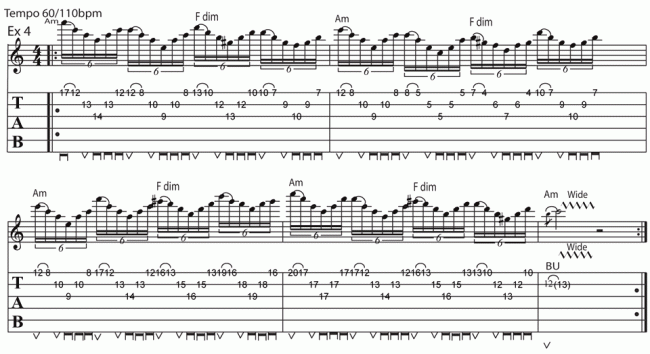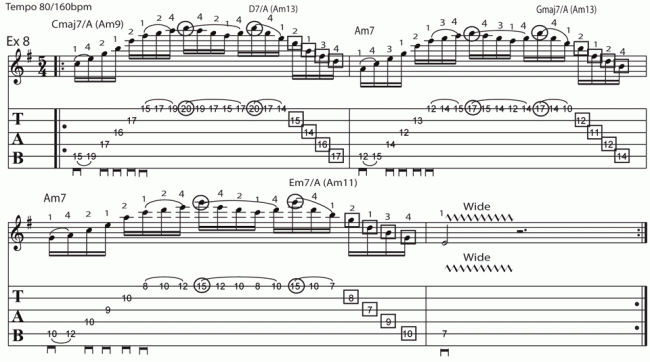
Ex 1: This example is in the style of rock guitar virtuoso Yngwie Malmsteen who released his incredible debut album “Rising Force” in 1984. This Sweeping pattern targets the upstroke motion and descends through the A minor inversions, before ascending back up A diminished. On the A minor triads, the second beat is fingered 4 and 1 on the high E string, followed by finger 2 on the B string and finger 1 on the G string. On beat 3, you will need to barre and roll the fretting hand index finger across the three strings The A Diminished retains the same exact shape as it ascends and is fingered 4 and 1 on the high E string, followed by finger 2 on the B string and finger 3 on the G string. On the upstroke Sweep, try to feel the pick pulling up through the strings, like a stick through park railings, all in a single motion. The fretting hand articulate each note individually rather than holding the chord shape. This technique is finger on, finger off and you should listen out for clean note separation.
Audio clip: Adobe Flash Player (version 9 or above) is required to play this audio clip. Download the latest version here. You also need to have JavaScript enabled in your browser.
Ex 2: This next example is another Yngwie Malmsteen style lick in sextuplets that utilises a quick succession of ascending A minor Sweep triads into a bend on the high E, fifteenth fret from the b7 up to the root note A. Follow the picking directions, gently palm muting the Sweep downstroke and target the first note of each beat by very quickly sliding the little finger into position.
Audio clip: Adobe Flash Player (version 9 or above) is required to play this audio clip. Download the latest version here. You also need to have JavaScript enabled in your browser.
Ex 3: Here we have an example which descends our sextuplet pattern in A minor and ascends with F diminished triad inversions. The F diminished triad can be played over E7 and implies an E Phrygian Dominant sound (R b2 3 4 5 b6 b7) E Phrygian Dominant is the fifth mode of A Harmonic Minor scale (R 2 b3 4 5 b6 7) Remember as formula that you can play diminished a semi-tone higher than the root note of a dominant 7 chord and you will have access to the Harmonic Minor sound. This is because the notes of the F diminished triad viewed from the perspective of E makes an E7b9 chord which is the V chord which leads us back to our resolving Aminor. On the example, try to tap your foot and sync up the metronome click to the upstroke on all except the first beat which is initiated with a downstroke.
Audio clip: Adobe Flash Player (version 9 or above) is required to play this audio clip. Download the latest version here. You also need to have JavaScript enabled in your browser.
Ex 4: This next example is again in the style of the great Yngwie Malmsteen and is comprised of A minor and F diminished (same as E7b9) inversions and is a V – I progression in A minor. The diminished triads will provide tension as they are functioning as a V in the key of A Harmonic Minor, which is resolved to A Natural Minor with the minor inversions. Exits on a half step bend up to the b3 of the resolving A minor chord. Altogether, the sound is classically based and would be influenced by classical single line instruments like violin and flute. Learn slowly by concentrating on a couple of bars at a time, gradually expanding until the whole piece has been memorised and after a couple of weeks of practice at learn speed, increase the tempo on a weekly basis.
Audio clip: Adobe Flash Player (version 9 or above) is required to play this audio clip. Download the latest version here. You also need to have JavaScript enabled in your browser.
Ex 5: This first example lays out the three main forms for the A minor triad (R, b3, 5). The first form starts from the b3rd and is in position 1, relative to the CAGED system. Starting off with a downstroke and hammer-on, all notes from the D string down are played using a sweep stroke or single motion. All notes should ring out evenly and separately with no dissonant clashes, finger on finger off. The second and third notes in bar 1, use the 4th finger to roll over the adjacent notes, however if you are higher up the fretboard in the key of Dm for example, it would be more common to use the third finger to execute the roll.
Finger choices may vary depending on where you are on the fretboard in some small cases such as this. On the top three strings, the fretting hand index fingerpad will roll across the strings with a slight pull back from the arm as well as a slight roll from the index finger pre-knuckle (last joint on finger under the nail). For the second form which starts from the 5th degree in bar 2, in order to play the first two notes without the hand jerking from side to side, position the thumb on the lower half of the middle of the back of the neck in order to maximise the stretch. This form covers both position 2 and 3 of the CAGED system territories.
Fingering wise, after the initial 1 and 4 on the low A string, use fingers 2, 1, 2, 1 ,4 for the remaining notes. On the third form, which is position 4 of the CAGED system, starting from the root in bar 3, again you will need to utilise the fretting hand rolling technique on the third and fourth notes which are played with the third finger. Once you have rolled from the third to the fourth note, the fretting hand third finger will serve to mute the previous note with its very tip, so careful and accurate positioning of the finger responsible for the rolling technique is vital to ensure good note separation. Likewise when descending to the roll, the third finger arrives on the G string muting the string above with its tip, before pinching onto the D string and raising up slightly from the previous note. All bars should at first be considered separate exercises, practiced for 5 minute at a time daily. After a week or two, try joining them all up and practice them all as an overall exercise.
Audio clip: Adobe Flash Player (version 9 or above) is required to play this audio clip. Download the latest version here. You also need to have JavaScript enabled in your browser.
Ex 6: Here we have an example in the style of rock virtuoso Jason Becker. Notice between the third and fourth notes of beat 2 in both bars 1 and 2, that there is a hooking round of the pick as the direction of the triad changes. Try to apply very light palm muting to the three downstrokes on the 3 string sweep triad. As the picking hand moves slightly from the arm downwards across the strings, try to mute off the notes that are left un-played with the side edge of the palm. Also bear in mind the usual advice of muting the string above the one being played with the tip of the fretting hand index finger as well as all strings underneath.
Audio clip: Adobe Flash Player (version 9 or above) is required to play this audio clip. Download the latest version here. You also need to have JavaScript enabled in your browser.
Ex 7:This next example, expands upon our 3 string ideas, and presents the full 5 string position 3 (C shape), Amin and Gmajor triads. They are both voiced with the root note on the low A string and along with the Right Handed Tap are 3 octaves in range. After the initial Sweeping stroke, Left Handed Tapping is utilised for the descent. Hammer down on the fretting hand notes hard and from a height at first, all notes should be even in velocity. Use the 2nd finger on the right hand to tap, holding the pick as usual so as to combine fluidly the Sweeping stroke which takes place over the actual fretboard.
Audio clip: Adobe Flash Player (version 9 or above) is required to play this audio clip. Download the latest version here. You also need to have JavaScript enabled in your browser.
Ex 8: Here we have a sixteenth note cascade of Sweep/Tap arpeggios superimposed over a static Amin7 chord. The line ascends one arpeggio and descends the next via a position shift on the high E string. Starting with position 4, Cmajor7 arpeggio, the line ascends with a Sweep stroke before a Legato and Tap full roll takes us to the second Right Hand Tap in beat 4 which must be executed with the fretting hand 4th (little) finger. At this point the hand moves back into a descending D7 arpeggio. From here the same kind of move applies to an ascending Amin7 arpeggio moving into a descending Gmaj7 arpeggio. To finish we move from an ascending Amin7 arpeggio in position 3 (C shape) to a descending Emin7 arpeggio before exiting on the 5th relative to our tonal centre of Amin7/ Dorian. Again this lick will need to be memorised in 1 bar phrases, gradually building up the lick in sections. Practice very slowly until a feeling of inner accuracy and tone develops before applying speed.
Audio clip: Adobe Flash Player (version 9 or above) is required to play this audio clip. Download the latest version here. You also need to have JavaScript enabled in your browser.










